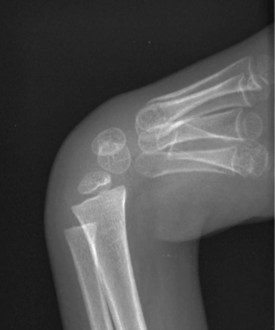Procedure 43 Carpal Wedge Osteotomy for Congenital Wrist Flexion Contracture (Arthrogryposis)
![]() See Video 35: Triceps Lengthening and Elbow Release in Arthrogryposis
See Video 35: Triceps Lengthening and Elbow Release in Arthrogryposis
Examination/Imaging
Clinical Examination
 The ability of the child to open and close the fingers should be determined. If the child does not have active finger extension, correction of the wrist flexion contracture will result in loss of ability to passively extend the finger by the tenodesis effect (Fig. 43-3).
The ability of the child to open and close the fingers should be determined. If the child does not have active finger extension, correction of the wrist flexion contracture will result in loss of ability to passively extend the finger by the tenodesis effect (Fig. 43-3).
 The function of the extensor carpi ulnaris (ECU) should be assessed. A transfer of the ECU to the radial wrist extensors may be required to improve wrist extension and diminish the ulnar deviation deformity.
The function of the extensor carpi ulnaris (ECU) should be assessed. A transfer of the ECU to the radial wrist extensors may be required to improve wrist extension and diminish the ulnar deviation deformity.
 It is important to examine the child along with an occupational therapist to evaluate the functional status of the wrist. This will help to determine the optimal wrist position in children who need surgery and to avoid surgery in children who have adapted well to the wrist flexion contracture.
It is important to examine the child along with an occupational therapist to evaluate the functional status of the wrist. This will help to determine the optimal wrist position in children who need surgery and to avoid surgery in children who have adapted well to the wrist flexion contracture.
 These children frequently have lower limb anomalies that can be corrected simultaneously to reduce the overall number of procedures.
These children frequently have lower limb anomalies that can be corrected simultaneously to reduce the overall number of procedures.
Positioning
 The procedure is performed under tourniquet control with the patient in the supine position. The degree of elbow contracture may complicate arm position during surgery. The tourniquet should be placed as high as possible to increase the surgical field.
The procedure is performed under tourniquet control with the patient in the supine position. The degree of elbow contracture may complicate arm position during surgery. The tourniquet should be placed as high as possible to increase the surgical field.
 Intraoperative fluoroscopy will be required to plan the wedge resection and to confirm position of the K-wires that will be used for fixation.
Intraoperative fluoroscopy will be required to plan the wedge resection and to confirm position of the K-wires that will be used for fixation.
Stay updated, free articles. Join our Telegram channel

Full access? Get Clinical Tree









